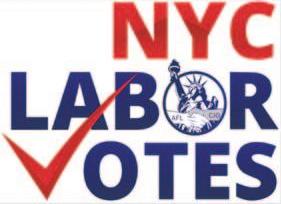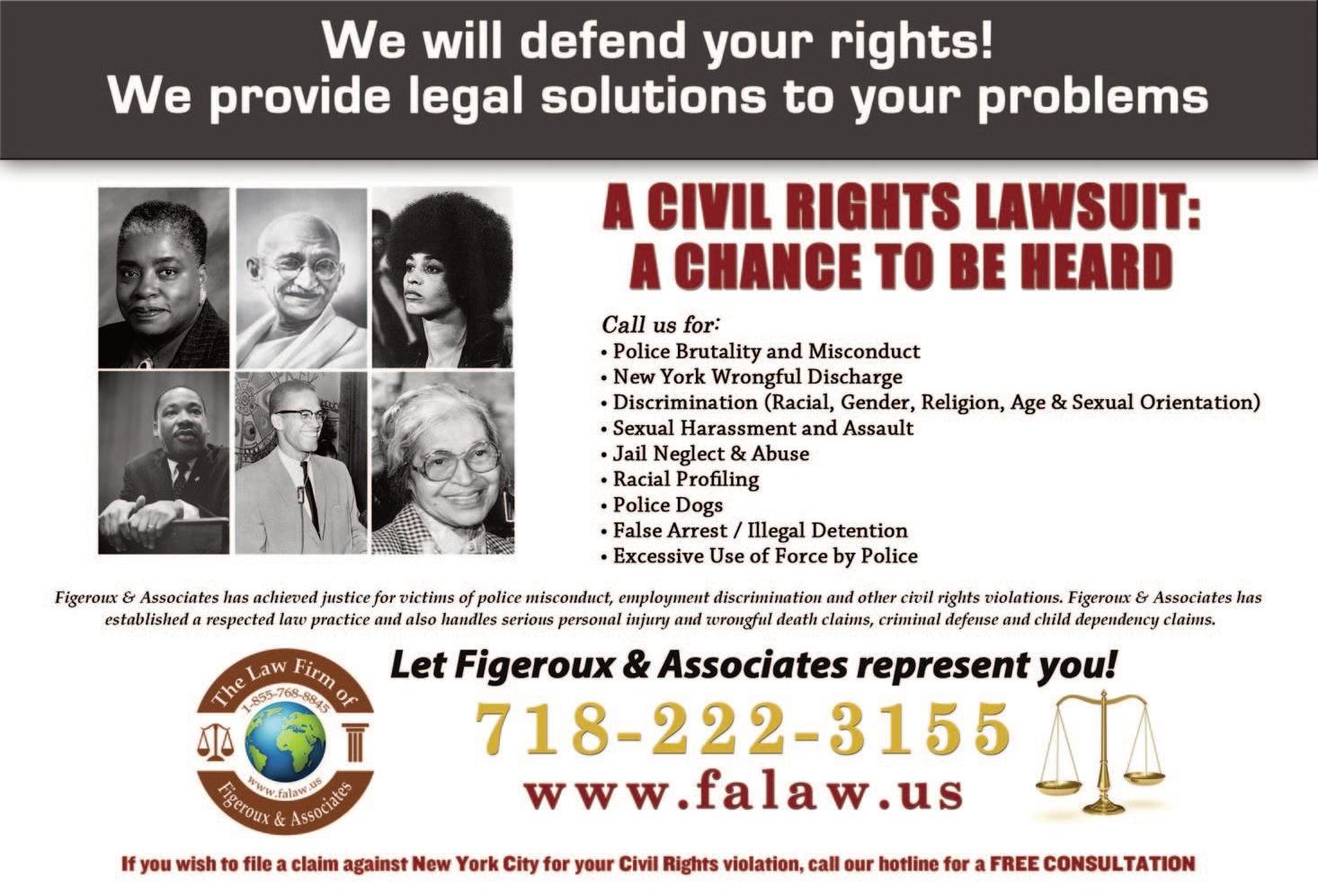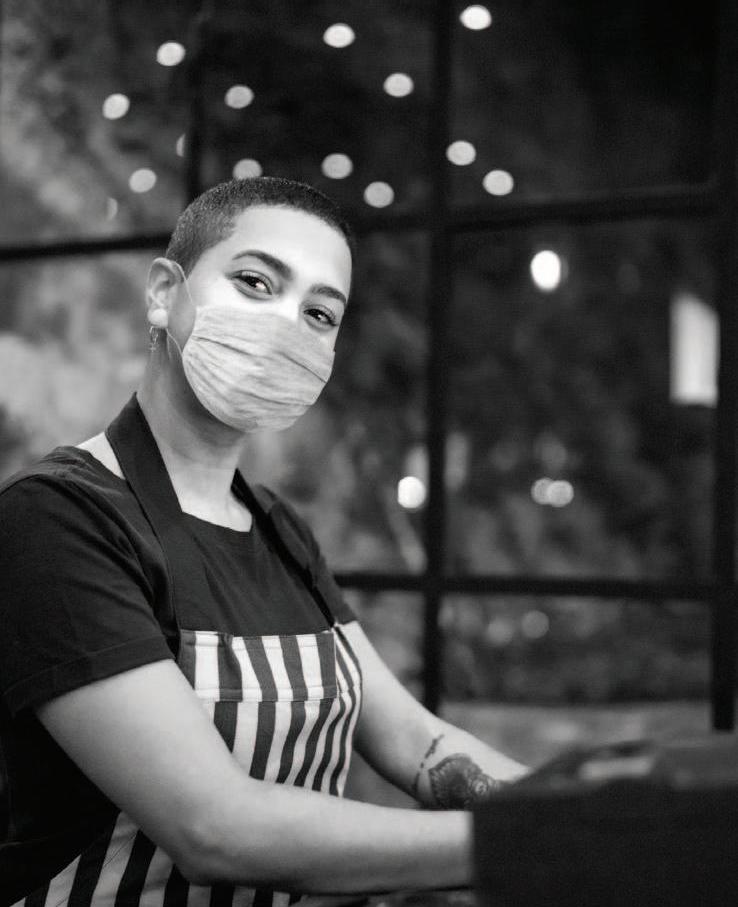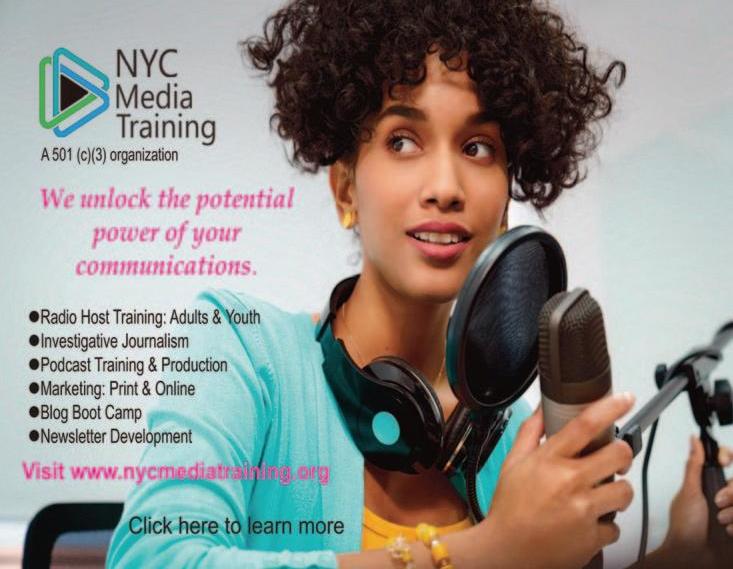
19 minute read
In Solidarity
Supports Workers’ World Today
Recently, I was in Albany fighting and seeking support of A1261/S1947, legislation that will create a clear definition of public work and level the playing field for New York’s contractors. District Council 9 Painters and Allied Trades Union (DC9), the union for painters, prides itself on being a strong advocate for workers’ rights and safety. We are excited about this new publication, Workers’ World Today, which covers the issues of relevance and concern for all workers. We are encouraged that all workers: blue and white collar will have a voice and platform. Congratulations on your inaugural issue. We wish much success to the leaders and team of Workers’ World Today and pledge our support.p Davon Lomax
Advertisement
Political Director, DC9
Elizabeth Warren and AOC Refuse to Cross New Yorker Union’s Picket Line
Senator Elizabeth Warren and U.S. Representative Alexandria Ocasio-Cortez are standing in solidarity with The New Yorker Union. Represented by The NewsGuild of New York, New Yorker Union members plan to hold an informational picket on Monday night to spotlight unfair labor practices at The New Yorker and to demand a just-cause provision in their Rep Ocasio-Cortez first collective bargaining agreement. The picket coinEditorial credit: Phil Pasquini / Shutterstock.com Senator Warren. Editorial credit: Rich Koele / Shutterstock.com cides with a New Yorker agement — led by editor azines and a failure to fairly Festival event scheduled to David Remnick and Condé compensate employees of feature Representative Oca- Nast CEO Roger Lynch — re- color. sio-Cortez and Senator War- fuses to agree to just cause, a “The NewsGuild and The ren. Both have agreed not to basic labor standard found in New Yorker Union are fightcross the picket line, and to other Guild contracts that ing for basic dignity on the job, withdraw their participa- guarantees due process, pro- and we stand with them,” Ms. tion in The New Yorker Fes- motes fairness and accounta- Warren and Ms. Ocasio-Cortez tival, until New Yorker bility, and creates consistent, said in a joint statement to The management agrees to the transparent standards in the New York Times. “We will not “just cause” standard of dis- workplace. This is an espe- cross the picket line and attend cipline that union members cially crucial protection for the festival unless the New have proposed. workers at Condé Nast, which Yorker leadership agrees to the The New Yorker is cur- has recently faced a public union’s demands — they rently in the midst of a labor reckoning over hostile work should do so immediately.” p dispute as company man- environments at multiple mag-

Take Action: Stop CBS News Union Busting Contract Violations
IBEW Local 1212 needs Yet months later, after layoffs cluding "CBS This Morning”" your voices! Local 1212 impacting IBEW members, and "Face the Nation." has a collective bargain- and despite the many griev- Take Action by calling CBS ing agreement covering em- ances the union has filed, CBS News Vice President of Operployees working for CBS News continues to violate the ations Rick Jefferson at 212News. In the early days of collective bargaining agree- 975-8517 and telling him that the pandemic, the union ex- ment by using non-union cam- CBS News must respect workhibited tremendous flexibil- era crews and third-party ers and let IBEW technicians ity while CBS News tried to vendors to conduct interviews do their jobs!p figure out the new normal. for their news programs in-

TEAM
Publisher Workers’ World Today, Inc
Editor-in-Chief Pearl Phillip
Contributing Writers Marilyn Silverman Charles Tabasso Victoria Falk Erin Telesford Jennine Estes, MFT Travis Morales Mary Campbell Janet Howard
Legal Advisor Brian Figeroux, Esq.
Telephone 1-866-435-3286
Email info@workersworldtoday.com
Visit us at www.workersworldtoday.com
As part of a robust member-to-member phone bank for the 2020 elections, the New York City Central Labor Council, AFL-CIO is conducting twiceweekly phone bank opportunities for NYC union members to reach out to other union households both in NYC and in battleground states, every Tuesday & Thursday from 11am-8pm. Volunteers will provide voters information on labor-endorsed candidates in their communities, as well as encourage members to call their legislators to ensure COVID-related legislation is passed and signed into law immediately.p

Here’s What’s At Stake With This Supreme Court Vacancy
BY JOSH BOXERMAN CIVILRIGHTS.ORG
Judge Amy Coney Barrett appeared before the Senate
Judiciary Committee. Chairman Lindsey Graham rushed to hold hearings on Barrett’s nomination to the Supreme Court. This is despite the Senate GOP’s failure to address the pandemic and provide relief to families and communities. Despite multiple members of the committee testing positive for COVID-19. Despite the fact that Barrett was only nominated 16 days before the start of the hearing. And despite the fact that – as of now – more than 22 million people have already voted for the president and senators they want to make this decision. In this rushed process, it is difficult to fully comprehend Barrett’s record. This was our only chance to see a nominee interview for a lifetime position on the Supreme Court. But
Washington, D.C./USA- September 19 2020: People holding signs up for Ruth Bader Ginsburg outside her death after her death. Editorial credit: Eli Wilson / Shutterstock.com

the hearing was not open to the public, and we’re still discovering missing records she didn’t previously disclose. The stakes could not be higher, and let’s be clear: what we already knew about Barrett is disqualifying:
Access to Health Care: While campaigning, President Trump promised that he would appoint justices to the Supreme Court who would overturn the Affordable Care Act (ACA). In Barrett, Trump has found yet another conservative extremist who passes this cruel litmus test. Barrett opined that the ACA is unconstitutional and agreed with the four dissenting justices who tried to overturn the law in King v. Burwell. Trump and 18 Republican state attorneys general are in court again seeking to overturn the ACA – and the Supreme Court is scheduled to hear that challenge on November 10. If confirmed, Barrett is expected to be the deciding vote to strike down the ACA, depriving millions of people of access to health care amidst the worst public health crisis this nation has witnessed in more than a hundred years. Without the Affordable Care Act, we would lose the crucial improvements it made to our access to health care. Protections for 135 million people with preexisting conditions and people with disabilities and critical nondiscrimination protections are at risk. Coverage for 15 million people under Medicaid expansion and 2.3 million young people on their parents’ plans are on the chopping block. We could go back to the days when insurance companies could place caps and lifetime limits on care and charge women significantly more than men. Overall, 20 million people would lose coverage, with disproportionate harm to people of color, especially Black and Latino communities.
Reproductive Health, Freedom, and Rights:
“Automatically” overturning Roe v. Wade was another part of President Trump’s litmus test. Barrett has a decades-long record of vocal opposition to reproductive rights: she suggested in a 2003 article that Roe was “an erroneous decision” and signed a 2006 public letter calling for the end of the legal right to abortion. She protested the ACA’s requirement ensuring comprehensive birth control coverage, and is associated with groups that oppose in vitro fertilization. In her short time on the Seventh Circuit Court of Appeals, these views have already made it into Barrett’s jurisprudence. If given the chance to join the Supreme Court, Barrett would represent a direct threat to reproductive rights in the United States. Antonin Scalia. Justice Scalia was among the five justices who threw out key provisions of the Voting Rights Act (VRA) in 2013, which had protected voters in many states from blatant acts of voter suppression. Scalia despicably called the VRA, one of the great achievements of the civil rights movement, a “racial entitlement.” Since that decision, which Justice Ginsburg famously described as “throwing away your umbrella in a rainstorm because you are not getting wet,” thousands of polling places have been shut down in areas that were formerly covered by the VRA. Many cases dealing with voter suppression are being argued in federal courts right now. Barrett, like Scalia, would be devastating for voting rights around the country.

Rights of Working People:
Barrett has ruled in favor of corporations and against working people. In one particularly disturbing case, Barrett ruled against an AfricanAmerican worker whose employer involuntarily transferred him to another store. The dissenting judges who disagreed with Barrett’s unjust holding wrote that this position permitted a “separatebut-equal arrangement” where the company – AutoZone –was placing Black employees in Black neighborhoods and Latino employees in Latino neighborhoods. Separate but equal is never equal. Especially after dozens of Trump judicial nominees refused to affirm that Brown v. Board of Education was correctly decided, it is completely unacceptable to have a Supreme Court nominee who disregards one of the basic precepts of civil rights in order to rule in favor of a corporation.
Immigrant Rights: Barrett has a record of ruling against immigrants. She dissented from her Seventh Circuit colleagues to side with the Trump administration in a challenge to its public charge rule, a harsh policy designed to penalize immigrants who utilized public services like Medicaid or food stamps. She also ruled against an immigrant seeking asylum and upheld the denial of a visa continued on page 5
Supreme Court Vacancy/
continued from page 4 application to the wife of a U.S. citizen. In June, the Supreme Court narrowly prevented the Trump administration from ending the Deferred Action for Childhood Arrivals program. With Barrett on the bench, anti-immigrant extremists could have the five votes they need to open up hundreds of thousands of undocumented Americans to deportation from the only country they have ever known.
Disability Rights: In the Seventh Circuit public charge case, the majority held that the Trump administration rule discriminated against immigrants with disabilities in particular. Barrett disagreed in her dissent. And she joined a decision that would allow for the exclusion of children with learning disabilities from school districts based on their service needs. The logic behind that decision, if applied broadly, would grant legal immunity to many egregious and discriminatory practices and the erosion of civil rights for people with disabilities. LGBTQ Equality: In recent years, the Supreme Court has made great strides in the recognition of the rights of LGBTQ people. Marriage equality became the law of the land in 2015 due to a 5-4 decision, and this year the Court affirmed 6-3 that LGBTQ people facing discrimination in the workplace are protected by civil rights laws. Barrett’s views on these issues place her far outside the judicial mainstream: at an event in 2016, she lamented the outcome in Obergefell v. Hodges and agreed with the four dissenting justices, and asserted her personal view that transgender people are not protected by sex discrimination provisions of civil rights laws. If allowed to link up with her ideological colleagues on the Court, two of whom stated this month that they believe Obergefell was wrongly decided, Barrett would be in a position to halt our progress, and chip away and roll back these hard-won rights and protections.
Criminal Legal System: As a judge, Barrett has a pattern of ruling for law enforcement and against defendants in criminal cases and people in prison. When the Seventh Circuit ruled to reduce a defendant’s sentence from 50 to 20 years, Barrett sided with the Trump administration’s attempt to keep the harsh sentence intact. Barrett dissented from her colleagues to side with two prison guards who had significantly injured inmates with buckshot, finding their actions to be “reasonable.” And again in dissent, Barrett found no constitutional issue with a trial judge who had ordered a defendant’s lawyer to remain silent during questioning. Bringing fairness and dignity to our legal system is one of the most profound civil and human rights issues of our time. The unequal treatment of people of color and people who are low-income undermines the progress we have made over the past five decades toward equality under the law. Justice Ginsburg understood this. Our next Supreme Court justice must do the same. Barrett on the bench would be devastating. But you can do something about it. Chairman Graham and Majority Leader Mitch McConnell are doing everything they can to confirm Barrett before Election Day so she can be in a position to side with Trump on the ACA, election-related disputes, and more. We must do everything we can to stop this unprecedented process. Call your senators – if they’re in the fight, ask them to do more, and if they’re not, hold them accountable. Engage with us on social media using the hashtags #OurCourt and #BlockBarrett. We are all in this together, and our rights are on the line. p


Josh Boxerman is the policy and research associate at The Leadership Conference on Civil and Human Rights.
COVID-19 Vaccinations/
continued from page 4 vaccine. While that might protect most people who get vaccinated, research suggests it may be insufficient to reach herd immunity and stop the virus’s spread. As a law professor who has written about the legal questions around vaccination laws, employment discrimination and religious exemptions, I see four possible approaches that governments and employers can take to ensure enough Americans are immunized against COVID-19. Which ones are legal might surprise you.
Can governments require vaccinations?
The most intrusive policy would involve government mandating vaccination for all Americans, with the exception of those with a medical exemption. People are often surprised to learn that states would likely have the legal right to enforce such a rule. In the 1905 landmark case Jacobson v. Massachusetts, the United States Supreme Court upheld the constitutionality of a state criminal law that required all adult inhabitants of Cambridge to get a smallpox vaccine or be fined. The Supreme Court explained that an individual’s liberty rights under the U.S. Constitution are not absolute and the mandatory vaccination law was necessary to promote public health and safety. While Jacobson v. Massachusetts is over 100 years old, courts continue to rely on the reasoning of the case. State governments still occasionally enact broad compulsory vaccination policies. In 2019, in the midst of a measles outbreak, New York City mandated that anyone over six months of age who lived, went to school or worked in several ZIP codes within the city had to be vaccinated against measles or be subject to a fine. Requiring people to be vaccinated against the SARS-CoV-2 coronavirus could similarly be justified by government’s need to promote public health and safety. In late May, the New York State Bar Association’s Health Law Section even recommended mandatory COVID-19 vaccination for all Americans. Yet in the United States today, where even mask mandates are controversial, it is unlikely that many states will enact a compulsory vaccination policy for everyone. Additionally, there is a risk that heavy-handed public health tactics can backfire and escalate tensions, increase mistrust of government and unintentionally increase the influence of the anti-vaccination movement.


What if only some people must get vaccinated?
A less intrusive tactic would be for state governments to require COVID-19 vaccinations for only certain segments of the population. All 50 states currently have some type of compulsory vaccination laws covering K-12 schoolchildren, and many states have compulsory vaccination laws covering college students. These laws typically allow for some type of medical exemption. States may also have mandatory vaccination laws covering employees in nursing homes and health care facilities. If states required this type of targeted mandatory COVID19 vaccination, they could cover those most at risk and those most likely to be in contact with others in ways that could stem the virus’s spread. Another approach would be legislation that requires proof of vaccination to obtain a passport, use public transportation or go to a gym. One of the most controversial issues surrounding compulsory vaccination laws is the religious or philosophical exemption, which some states have eliminated in recent years. In the aftermath of the recent measles outbreaks, both New York and California eliminated these exemptions from vaccination laws covering schoolchildren. Courts have explained that while compulsory vaccination laws may burden religious practices, religious exemptions are not constitutionally required under the First Amendment’s free exercise clause since mandatory vaccination does not single out religion and is not motivated by a desire to interfere with religion.
What can employers require?
Private employers have significant flexibility for requiring vaccination. Yet few businesses outside of health care facilities have done so, partly out of fear that employees would consider these policies to be unacceptable invasions of their personal lives. There is a risk in a unionized workplace that a mandatory vaccination policy could be struck down if it violates a collective bargaining agreement. However, unlike government-mandated policies, these would not be subject to constitutional restrictions. Employers may also be concerned that if policies do not include significant religious exemptions, workers could sue, claiming religious discrimination. However, it is unlikely that federal law would require employers to accommodate employees requesting a religious exemption to a COVID-19 vaccine. Under Title VII of the 1964 Civil Rights Act, the federal law prohibiting religious discrimination in the workplace, employers are not required to accommodate religious employees if doing so involves more than a de minimis, or minimal cost. Certainly, in the midst of one of the worst public health and financial crises in recent history, there is a significant cost to having an unimmunized workforce.
Setting an example
Beyond mandates and laws, employers, politicians and government agencies have other ways to encourage people to get vaccinated. In particular, the messages they send matter. That was evident in the public controversy over maskwearing after President Donald Trump and other prominent Republicans ridiculed the precaution. In New York, Gov. Andrew Cuomo mandated wearing face masks in public, but he also successfully convinced New Yorkers to wear them by emphasizing that doing so showed respect for others, particularly essential workers, health care providers and high-risk individuals. Government can similarly encourage Americans to get vaccinated through education campaigns led by trusted community members, such as religious leaders or celebrities. During the New York measles outbreak, the Orthodox Jewish Nurses Association was at the forefront of educating the Orthodox Jewish community on the safety and efficacy of vaccination. Government and employers also could make vaccines free and available at convenient locations. As the U.S. government fast-tracks the development of potential vaccines, it’s important to remember that a COVID-19 vaccine will stop the virus only if enough people get vaccinated. Now is the time for governments and employers to develop policies to ensure it succeeds.
Early Voting Starts October 24: Vote Safely & Know Your Rights

Right to Refuse Dangerous Work/
continued from page 1 refusal. Also, any complaints related to retaliation from the employer have to be filed within 30 days of the reprisal.
•Your right to refuse to do a task is protected if all of the following conditions are met: •Where possible, you have asked the employer to eliminate the danger, and the employer failed to do so; and You refused to work in “good faith.” This means that you must genuinely believe that an imminent danger exists; and •A reasonable person would agree that there is a real danger of death or serious injury; and •There isn’t enough time, due to the urgency of the hazard, to get it corrected through regular enforcement channels, such as requesting an OSHA inspection. Collective action is also bolstered further by workers’ right to “concerted activities for… mutual aid or protection” under the National Labor Relations Act, which governs most private sector employment. The Labor Board agrees that “participating in a concerted refusal to work in unsafe conditions” is protected.p
Early voters line up outside of the Brooklyn Museum before the polls open on Saturday, Oct. 24, 2020. Photo: Peter Senzamici/THE CITY Election season is upon us and in these unprecedented times, we need to ensure that we don’t waste our vote. Make sure to vote on or before Election Day: •Vote early between October 24 and November 1 •Vote-by-mail ASAP •Vote on Election Day on November 3 and wash your hands with soap and water immediately after you get home. Avoid touching your face with unwashed hands. •Practice physical distancing. Polling places will be set up to ensure physical distancing. Follow instructions and stay at least 6 feet away from others while at your polling site. •Avoid long lines and crowds. If you Your vote is your voice. Be heard this election. Learn more about early voting, vote by mail, and finding your polling place at voting.nyc. can, vote early (before Election Day) or go when your voting center is less busy, usually mid-morning or early afternoon. Stay home if you are sick. Voting is What is early voting (EV)? Early voting happens 9 days in a row before the election and allows you to important, but it’s more important that you get well and keep New Yorkers safe! vote in-person on weekdays, weekends and evenings, from October 24 through November 1. Can I bring an interpreter with me into the voting booth? In any election, you have a right to be What interpretation services are available? Interpretation services will be provided on the weekend before election day (October 31st and November 1st) across 25 sites in at least two languages per poll site. There also will be assisted by any person of your choice (except your employer or union representative), including a trained poll worker, if you need help to vote. If you need an interpreter, interpreters are available to assist voters at selected sites. language assistance at 52 poll sites on Election Day. Check which poll sites support which languages at: nyc.gov/wearevoters Which languages is interpretation offered in? The New York City Board of Elections provides language assistance in SpanIn-person voting precautions If voting in person, follow simple precautions to protect yourself and others from COVID-19: •Wear a face covering. Face coverings are required to enter all polling sites. Protect those around you and wear a face covering correctly (over your nose and mouth). •Practice healthy hand hygiene. Polling sites will provide hand sanitizer, and you can also bring your own. Use hand sanitizer before and after touching any shared surfaces, ish, Chinese, Korean, Bengali, Punjabi, or Hindi at select City poll sites. Call 866-VOTE-NYC for information about which poll sites have language assistance available and for which languages. The Civic Engagement Commission is providing language assistance in Arabic, Bengali, Chinese (Cantonese, Mandarin), French, Haitian Creole, Italian, Korean, Polish, Russian, Urdu, Yiddish at selected poll sites on October 31, November 1 and November 3. To check which poll sites and languages, go to: nyc.gov/wearevotersp

IF YOU CAN’T TAKE TIME OFF ON ELECTION DAY, NO PROBLEM.






